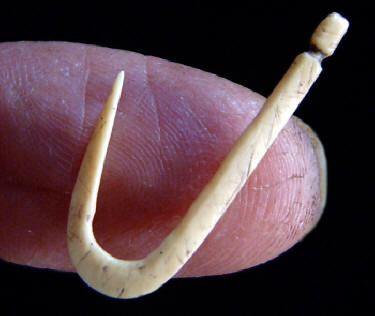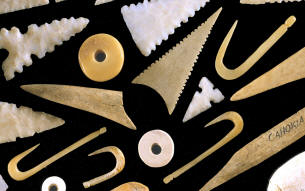|
BONE FISHHOOK
CAHOKIA MOUNDS SITE
MISSISSIPPIAN CULTURE
ST. CLAIR COUNTY, ILLINOIS
PRIVATE COLLECTION
COPYRIGHT AUGUST 31,
2010 PETER A. BOSTROM

CAST ILLUSTRATED
CAST
#M-16
BONE FISHHOOK
CAHOKIA MOUNDS SITE
MISSISSIPPIAN CULTURE
ST. CLAIR COUNTY, ILLINOIS
PRIVATE COLLECTION
This bone fishhook was found
several years ago in a cultivated field on the Cahokia Mounds Historic
site. It was found in a cache of six or seven other fishhooks. This
fishhook appears to be made from deer bone and possibly the toe bone of
a deer.
An estimated date for this fishhook is somewhere between A.D. 900 to
A.D. 1300.
Fishhooks have been found on Mississippi, Woodland and Archaic
sites. Bone fishhooks 8,000 to 9,000 years old were found in Nebraska (Wormington,
1957: 138).
To the Mississippian
people, fish were an extremely important source for concentrated
protein. The bones from several different varieties of fish such as
flathead catfish, alligator gar, drum buffalo, largemouth bass, walleye,
channel catfish, bowfin, gar and suckers are found in abundance on many
Mississippian village sites.
Fishing techniques varied greatly just as they do today. The use of
nets in pools left by receding floodwater would account for large and
easy catches. The use of harpoons, hooks and gorges would produce much
lower volumes of fish.
The paucity of fishhooks on Mississippian sites suggests angling
was of relatively little economic importance. Most fishhooks were
probably used on trot lines rather than the single lines and poles we
use today.

BONE FISHHOOKS & MISC. ARTIFACTS
CAHOKIA MOUNDS SITE |

